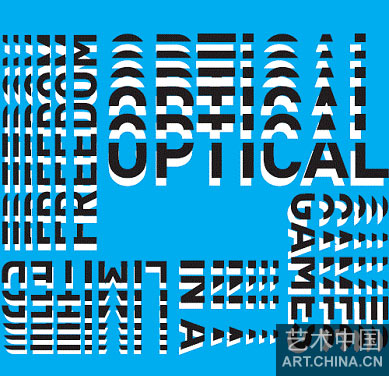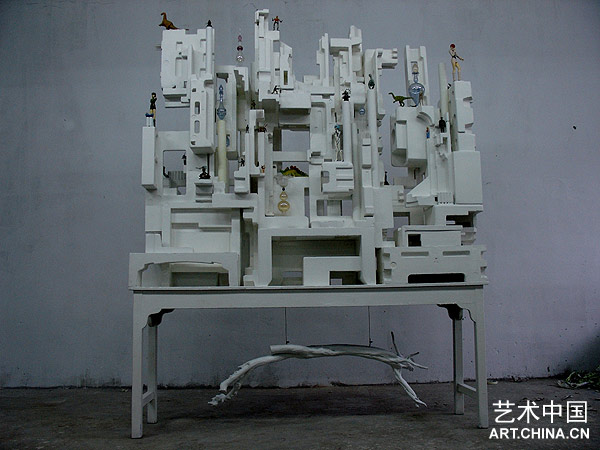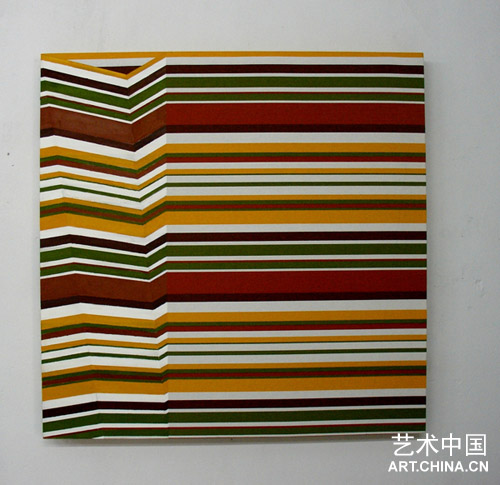|

WANG QIANG
王強
OPTICAL GAMES IN A LIMTED FREEDOM
有限自由裏的視覺遊戲
Date of the Show: March 8th – April 20th , 2008
展覽時間: 2008年3月8日- 4月20日
Opening: March 8th , 5-7pm
展覽開幕式:3月8日, 下午5-7點
Venue: Marella Gallery
地點:瑪蕊樂畫廊
OPTICAL GAMES IN A LIMITED FREEDOM
"Who's Afraid of Red, Yellow and Blue?"
If we take into analyses the paintings of the series Limited Freedom, we could place Wang Qiang among those few artists that undertake a rigid geometrical abstraction. Already within the title, the artist reclaims the concept of freedom that, also in the West between the beginning of the Twentieth Century and the end of the Second World War, had ratified the birth of Abstractism.
Abstractism, as a universal language, is in fact free from any kind of ties with reality and from any attempts with figuration. Wang Qiang, as abstracters did in their times, deprives painting of the realism bestowing it with the faculty of the word and turning it into a tool to express the subjectivity of the artist and a place for the visual immersion of the spectator.
In the Athens of the IV B.C, Platone had already written something about painting: "for what concern the beauty of the shapes, I don't think about what most people could imagine, for example beautiful painted bodies. I rather mean the straight line or the circle, the plane and solid figures, designed with the ruler and the SQUADRA. I believe these figures are themselves very beautiful, because they transmit a particular pleasure".
But what kind of pleasure could we ever find in the mess of colors and in the overlapping of lines?
The artist refuses to give the spectator interpretational hints and his canvases become just a simple pretext for contemplation because, as Leonardo in the Fifth Century pointed out, "messy and indefinite things stimulate the spirit to new inventions". Hence, the meditative quality conferred by a meticulously maniacal geometry is undoubted!
The figurative "emptiness" of Wang Qiang's canvases confers full scope to the feelings and emotions of the observer who carries out a somewhat mystical submersion in the colors letting his retina being confused by the chromatic cheats and optical games created by the lines.These works enclose the intrinsic value of recalling only themselves just like the masterpieces of the Op Art (Optical Art) anticipated in the Thirties by Victor Vasarely. Through the linear variations (vertical, horizontal and diagonal) and the contrasts of colors, he experiments the effects of optical stimulation and the false impression of movement that has been created.
However, for which reason is this "freedom""limited"? Only approaching the canvases, we can comprehend the mock and amusement of these artworks: the patterns are prefixed and they already exist, and the newly painted part is only partial. The canvases are already colored and printed with the lines and motifs of which, only in some portion of the space, the artist inverts and upsets the direction, creating with the brush geometries of geometries and making these labyrinths even more complex.
Illusions and mirages recall to the structures of a computer or to the trajectories of a video game to which the artist confers a three-dimensional form with his installations. Complex architectures emerge from the polystyrene to create intricate buildings behind whose slants and niches are placed, hidden, small figures: animals, characters of comics and strange beings that seem to be part of a different universe. It seems a futuristic and science fictional scenery, a world inspired by cartoons that once again submerge the viewer in a surreal dimension deprived of time and space.
Eleonora Battiston
有限自由的視覺遊戲
"誰害怕紅, 藍, 白?"
如果從「有限的自由」系列創作中分析,王強可説是少數幾位敢於挑戰幾何抽象的藝術家之一。如同文章標題已經闡釋,藝術家如今重新訴求於自由的概念,這自由的概念曾促使抽象主義誕生於20世紀初和第二次世界大戰結束間的西方社會。抽象主義像是一種共同語言,它能解開任何現實繩索及開放任何形象的嘗試。如同其他抽象藝術家曾為他們的時代所作過的,王強剝除繪畫的現實性並賦予它表述功能,使它變為一種表達藝術家主觀的工具,同時,也成為觀賞者視覺上的洗禮之地。
在西元前第五世紀時期的雅典,柏拉圖寫下了對繪畫的思考:"談到關於形狀的美感,多數人想到的可能是被畫出的美麗肉體,但我不這樣認為,我更認同的形狀美感,應該是那些用尺規和方形框框所設計出來的直線或圓圈及平面和立體圖形。我相信這些圖像本身已經十分美麗,因為他們傳達出一種精確獨特的愉悅感受"。
但在混亂的顏色和重疊的線條中,我們能夠發現什麼樣的樂趣呢?藝術家拒絕提供觀賞者解讀的線索,他的畫作僅僅是讓人可以靜觀默想的單純藉口,就像是列奧納多•達•芬奇(Leonardo)在第五世紀中所指出,"混亂和不確定的事物能夠激發出創新發明的精神".無庸置疑,精確的狂亂幾何賦予了冥想的品質。
王強作品中形象化的"空虛"留給觀賞者充分感受的空間,讓觀賞者被一種神秘的色彩淹沒,他們的視網膜被彩色欺騙而迷惑,他們進行著由線條創造的視覺遊戲 。這些作品包含著由自身索引發的內在價值,如同1930年代歐普藝術大師維克托•瓦薩雷裏(Victor Vasarely)的開創作品。通過線性變化(縱向,橫向和對角線)和對比的色彩,王強對於視覺刺激作用的影響的實驗和産生錯覺的運動已經建立了。
然而,什麼原因造成了這樣的"自由"是 "有限"的呢? 只有走近畫作,我們才可以領略這些藝術作品的嘲弄和娛樂:圖案式樣是預先放置在畫布上的,他們早已存在,而新畫的一部分只是局部的延伸。畫布上已先上色並印上線條,而在這空間中的某一部分,藝術家從倒置及弄翻的方向創造出幾何形式的繪畫風格,同時,也讓這些迷宮的線條和主題更加複雜。藝術家將幻覺和海市蜃樓以 立體形式的裝置作品呈現,讓人聯想起電腦的結構,或是電腦遊戲中的軌道。由聚苯乙烯産生的合成建築結構,打造出錯綜複雜的建築物,這些建築物的後方有著斜坡和壁龕、隱蔽的小塑像:動物、漫畫人物和古怪的生物,這些看起來似乎屬於另一個宇宙。這個看似未來派和科學虛構的風景,這個從卡通啟發的世界,再次讓觀賞者沉浸在一個剝離了時間和空間的超現實次元中。
葉蘭
Marella Gallery 瑪蕊樂畫廊
4 Jiuxianqiao Rd., 798 Art District, Beijing
北京市朝陽區酒仙橋路4號798藝術區
www.marellabeijing.com
8610-6433 4055

Marella Gallery Beijing
Wang Qiang
《邊角料·世界》
《unused material·The World》
200×50×260 cm

Marella Gallery Beijing
Wang Qiang
《有限的自由07—6》
《Limited Freedom07—6》
125×125cm
|

